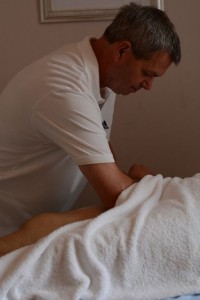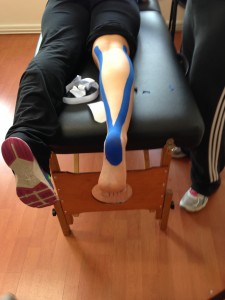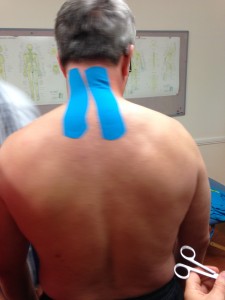
Sport Massage
Having trained in both basic Sports Massage and more advanced Sports Massage Therapy, I customise every treatment to each individual client. An initial consultation ensures that massage is both safe and appropriate for you, and identifies your particular needs that I will focus on. A normal session will start with a thorough assessment of your gait (walk) and posture and incorporate ROM (Range of Movement) tests of any area of your body affected by injury. This assessment will continue as I carry out the massage, palpating for any areas of tension or muscle knots. As any problem soft tissue areas are located, these are worked on with a variety of techniques to begin restoring the tissue to its correct condition and function. This process can take several sessions, and it is necessary for clients to have a realistic approach and not expect to see dramatic results from just one session. Accordingly, at the end of your first session, I will work out a treatment plan with you, which will include suggesting useful stretches and exercises that you can do in your own time in-between massage sessions to assist your rehabilitation.

Benefits of Advanced Sport Massage:
Sport Massage therapy is useful for competitive athletes and individuals pursuing sports for leisure and fitness, as well as the general public, to assist the rehabilitation of anyone recovering from injury. However, this is not all. To quote Mel Cash, a leading clinical massage therapist, Sports Massage “is an incredibly versatile technique which can be applied in an infinite variety of ways to release areas of scar tissue and adhesions, and restore elasticity to the muscles” (Advanced Remedial Massage and Soft Tissue Therapy, 2012). For professional athletes and active sportsmen and sportswomen, it can provide targeted support pre- and post-event or in-between competitions or training sessions, enhancing performance and recovery by addressing soft tissue issues, such as muscle tightness or facia restrictions, and helping to maintain muscles in good working order.
The benefits of Sports Massage are numerous:
- It helps locate and remedy soft tissue problems.
- It relieves muscle aches and pains, tension, soreness, and stress.
- It is said to improve blood flow and lymph drainage to problem areas, performing a remedial function in assisting and encouraging the body’s self-healing.
- It can increase mobility and movement range of injured limbs and strained muscles.
- It can help reduce and better manage chronic pain and chronic conditions.
- It can loosen tight scar tissue and improve muscle suppleness.
- It helps maintain overall muscular health and strength.
Typical Techniques employed in Advanced Sports Massage:
- Soft Tissue Release helps treat micro-tears within tissues and muscles that most need lengthening so as to get rid of feelings of tightness and discomfort. This is achieved through gentle compression and by locking the problem muscles into specific positions before the therapist performs a set of stretches. These stretches may be passive (with the therapist performing the stretch on the client), active (with the client initiating the stretch supported by the therapist), or weight-bearing (involving combined active and resisted movement). Soft Tissue Release can be used all over the body, wherever it is needed. Examples of typical sports injuries where this technique is applied are a pulled hamstring and Achilles Tendonitis.
- Trigger Point Therapy involves the longer application of isolated pressure to particularly painful points/areas from which pain radiates outwards to affect other, non-injured parts of the body. (For instance a trigger point in the back may cause neck pain and hence a headache also.) During the technique, the client actively participates by relaxing and ‘breathing into’ the pain instead of resisting it. When the trigger point is subsequently released, the affected area de-constricts, helping to alleviate the discomfort and disrupt the body’s established pain patterns that can contribute to chronic pain. Receiving Trigger Point Therapy as part of regular massage can help retrain the body and more effectively manage recurrent pain and stress arising from chronic conditions, as well as promoting a return to natural movement.
- MET (Muscle Energy Technique) is a form of manual manipulative stretching treatment involving the active contractions of clients’ muscles performed in specific directions at the therapist’s guidance, while the therapist provides an appropriate counterforce. This technique is employed to decrease muscle tenderness and improve a client’s restricted range of muscle and joint motion, for instance resulting from hypertonicity following overuse in high performance sports. MET also aims to prevent the muscles adjoining or related to the dysfunctional area from becoming affected, which would further exacerbate the client’s discomfort. This is achieved by using gentle contractions to relax and then stretch and elongate the problem muscle fibres to their fullest potential. This realigns the muscles and the joints to which they attach, which may have been pulled out of their normal positions by the client unconsciously trying to protect against the pain. A typical condition which is treated with this technique is sciatica. Some athletes also find MET useful in building muscle strength and as a preventative measure to safeguard against injury before a strenuous training session or pre-event.
- PNF Stretching (Proprioceptive Neuromuscular Facilitation) refers to enhanced stretching techniques, incorporating both active (isometric) and passive (static) movements, employed as a form of rehabilitation for injured muscles as well as a means of optimising the functioning of healthy muscles. It is deemed one of the most effective ways of quickly increasing flexibility, by retraining the muscles’ stretch receptors and inhibiting the muscles’ tendency to contract against a stretch. In this technique, a muscle group is first stretched and held for a specific duration in the same position; while still in this position, the muscle group is then contracted against appropriate resistance supplied by the therapist; finally, it is relaxed and stretched again, but slightly further this time with assistance from the therapist. The stretches are performed in sets, with periods of rests in-between. PNF Stretching can significantlyimprove the client’s motor performance and range of possible movements, especially when undertaken in support of a dedicated exercise or rehabilitation programme. An example of an injury treated with this technique is a pulled leg muscle. (Note: It is generally advisable to avoid PNF directly or shortly before a competition; PNF is also not recommended for children, since their bones are still growing, or for clients with osteoporosis.)
- KT (Kinesio Taping) and Strapping can be useful tools to aid recovery from injury, and to assist the function of and offer a degree of protection to undamaged joints while continuing to train or compete. As Keith Ward, Lecturer in Sports Therapy, explains, this is especially important since “it is virtually impossible to rest an injured structure completely”, but also because these techniques enable the athlete to undertake “progressive rehabilitation exercises” (Hands-On Sports Therapy, 2004), which might not be possible otherwise. Once applied, the tape and strapping are usually left in place for several days, providing extra support and restriction to problem areas, so as to correct improper posture and inhibit excess or incorrect movement that might inadvertently injure or further damage muscles, joints, and ligaments. A case study of the use of the technique for clients with Tennis Elbow not only demonstrated a resulting pain reduction, but also “an impressive effect on wrist extension force and grip strength of patients with TE” (Alireza Shamsoddini and Mohammad Tahhi Hollisaz, ‘Effects of Taping on Pain, Grip Strength and Wrist Extension Force in Patients with Tennis Elbow’, Trauma Monthly 18:2 [Sept. 2013]: 71-74,http://www.ncbi.nlm.nih.gov/pmc/articles/PMC3860678/). Additionally, KT (Kinesio Taping) and Strapping can afford some pain relief by reminding the wearer that particular movements or body postures may need to be temporarily (or permanently) modified to allow the problem area to fully recover. (Note: Care must be taken, however, that the athlete does not continue to train or compete when the injury is such that what the affected area most requires is complete rest.) I offer the more traditional taping and strapping, where a strong tape is used to help hold muscles and ligaments in a particular position to counteract undue stress on the fibres, as well as the lighter, multi-coloured Kinesio taping often seen on professional athletes, which permits a wider, more normal range of movements.


